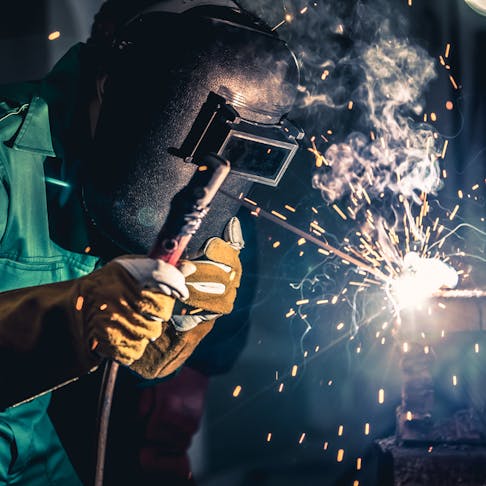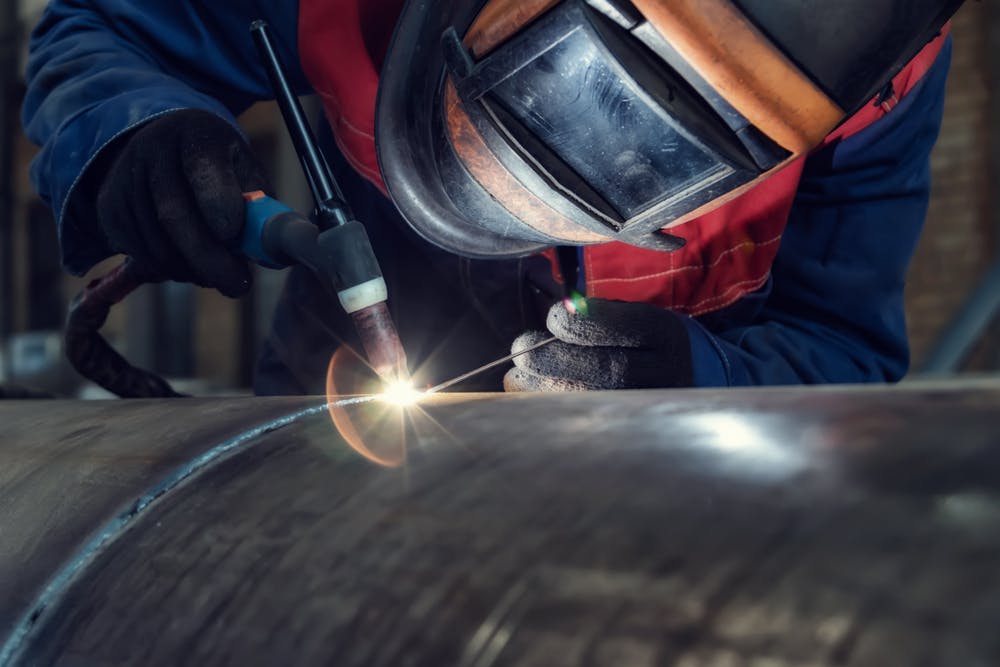
SMAW vs GMAW: What Are the Key Differences?

SMAW (shielded metal arc welding) and GMAW (gas metal arc welding) are two welding processes that have distinct characteristics and applications. SMAW or stick welding uses a consumable electrode coated with a flux that melts during the welding process. This flux helps protect the weld pool from atmospheric pollutants by forming a slag layer and a shield of shielding gas.
In contrast, GMAW, also known as Metal Inert Gas (MIG) welding, uses a continuously fed wire electrode and a shielding gas to prevent oxidation of the weld. GMAW is suitable for a variety of materials and applications because the wire electrode and shielding gas combination allow for faster welding and better process control. This article will further compare SMAW vs GMAW in terms of its uses, advantages, and disadvantages.
What Is Shielded Metal Arc Welding (SMAW)?
Shielded Metal Arc Welding (SMAW), also referred to as "stick welding" or "SMAW welding," is a manual arc welding procedure that makes use of a consumable electrode that has been coated in flux. When the electrode and workpiece form an arc, heat is produced that melts the electrode tip and creates the weld joint. SMAW is commonly used in construction, maintenance, and repair projects.
How Does Shielded Metal Arc Welding (SMAW) Work?
SMAW is a manual welding process. It involves creating an electric arc between a coated electrode (stick) and the part. The heat generated melts the electrode, which forms a weld pool, and the coating provides shielding gases that guard the weld from atmospheric contamination. As the weld cools, it solidifies and joins the workpieces together.
What Is the Main Use of Shielded Metal Arc Welding (SMAW)?
The main use of SMAW is for both repair welding and production purposes. It is versatile and applicable in all welding positions on ferrous metals, including steel and iron. SMAW's flexibility makes it suitable for a wide range of welding applications across various industries.
What Are the Advantages of Shielded Metal Arc Welding (SMAW)?
Advantages of SMAW include:
- Can be used on various ferrous metals.
- Requires minimal equipment, making it suitable for remote locations.
- Can be positioned in various ways.
- Lower equipment and operational costs compared to other welding processes like Tungsten inert gas (TIG) welding.
What Are the Disadvantages of Shielded Metal Arc Welding (SMAW)?
Disadvantages of SMAW include:
- Slag inclusions can be present in the weld when using SMAW, resulting in lower-quality welds with increased porosity.
- This welding process is intermittent since the electrode must be replaced periodically.
- Produces significant heat and smoke, requiring proper ventilation and safety measures.
What Is Gas Metal Arc Welding (GMAW)?
Gas metal arc welding (GMAW) is a welding process that uses a consumable wire electrode and a shielding gas to create an electric arc between the workpiece and the electrode. The heat generated melts the electrode tip, forming a weld pool, and the shielding gas protects the weld from atmospheric contamination. GMAW is commonly used in various industries for welding steel, aluminum, and other metals, offering high productivity and versatility. Figure 2 below is an example of gas metal arc welding:
Gas metal arc welding.
Image Credit: Shutterstock.com/shinobi
How Does Gas Metal Arc Welding (GMAW) Work?
GMAW works by creating an electric arc between the part and a continuous wire electrode. The electrode, which is fed through a welding gun, melts and combines with the workpiece to form a weld. A shielding gas, such as argon or a mixture of argon and carbon dioxide, is used to protect the weld zone from atmospheric contamination. The shielding gas also helps stabilize the arc and control the welding process.
What Is the Main Use of Gas Metal Arc Welding (GMAW)?
GMAW finds its primary application in semi-automated or automated industrial processes. Its remarkable versatility enables the welding of all commercially available metals, making it a go-to choice for deep groove welding of plates and castings. Furthermore, GMAW's ability to deliver high-speed performance makes it a preferred method for welding light gauge metals.
What Are the Advantages of Gas Metal Arc Welding (GMAW)?
Advantages of GMAW include:
- Offers faster welding speeds compared to other processes.
- Can weld a wide range of metals, including steel, aluminum, and stainless steel.
- Provides excellent weld appearance and soundness.
- Minimal slag and spatter formation.
- Well-suited for semi-automated or fully automated welding systems.
What Are the Disadvantages of Gas Metal Arc Welding (GMAW)?
Disadvantages of GMAW include:
- Limited portability compared to Shielded Metal Arc Welding (SMAW).
- Sensitivity to drafts or outdoor conditions that can disrupt the shielding gas.
- Requires specialized equipment, including a welding power source and shielding gas supply.
- The absence of a slag system in GMAW can make out-of-position welds more challenging at times.
How Does SMAW Differ from GMAW?
SMAW and GMAW differ in terms of the process. SMAW is a manual welding process using a coated electrode. It offers advantages such as: portability, outdoor suitability, and lower equipment costs. GMAW, on the other hand, is a semi-automated or automated process that uses a continuous wire electrode. It provides benefits like higher productivity, cleaner welds, and better parameter control.
How Do SMAW and GMAW Differ in the Types of Gas Used?
SMAW and GMAW differ in the types of gas used for shielding. SMAW does not rely solely on an external shielding gas. Instead, it utilizes a flux-coated electrode that releases a protective gas (which can include carbon dioxide and ozone) and slag. This combination creates a shielded environment around the weld area, safeguarding it against contamination and maintaining the weld's integrity. In contrast, GMAW relies on an external shielding gas, such as argon or a mixture of argon and carbon dioxide, for weld protection.
Why Is SMAW the Most Widely Used Welding Process?
SMAW (Shielded Metal Arc Welding) is the most widely used welding process due to its simplicity and self-contained nature. It does not require a separate shielding gas cylinder, making it highly convenient for on-site welding. Additionally, SMAW is relatively easy to learn and offers cost-effective solutions.
Is SMAW Stronger Than GMAW?
No, SMAW is not inherently stronger than GMAW. The strength of a weld depends on various factors such as welding technique, filler material, and base metal. Both SMAW and GMAW can produce high-strength welds when performed correctly and with appropriate materials.
Is GMAW the Same as MIG Welding?
Yes, GMAW is the same as MIG (Metal Inert Gas) welding. MIG welding is a commonly used term for GMAW. The process involves using a continuous wire electrode and a shielding gas that protects the weld from atmospheric contamination.
How Do GMAW and SMAW Differ in Material to Weld?
GMAW is renowned for its versatility, enabling the welding of diverse materials, including steel, stainless steel, aluminum, and non-ferrous metals. Conversely, SMAW finds its primary application in welding ferrous metals, specifically steel, iron, and cast iron.
Does GMAW Equipment Cost More Than SMAW Equipment?
Yes, GMAW equipment generally costs more than SMAW equipment. GMAW requires a welding power source, shielding gas supply, and wire feeder, which can contribute to higher initial costs. SMAW, being a more straightforward process, has simpler equipment requirements. It only requires a power source, electrode holder, ground clamp, and SMAW electrodes. This results in lower overall equipment costs. GMAW equipment tends to have a higher cost than SMAW equipment due to the additional components required for the process.
How Do SMAW and GMAW Differ in the Process?
SMAW, also known as stick welding, utilizes a flux-coated electrode that melts during welding. In contrast, GMAW, or MIG welding, employs a continuous wire electrode fed through a welding gun, and shielding gas is used to guard the weld from atmospheric contamination.
Is SMAW Easier To Use Compared to GMAW?
No, SMAW is not fundamentally simpler to use than GMAW. Due to challenges with managing the slag, maintaining the arc length, and manipulating electrodes, SMAW requires a higher level of skill and technique. In contrast, GMAW offers more automation and control, making it easier to operate and learn.
Summary
This article presented SMAW and GMAW, explained each of them, and discussed their key differences. To learn more about both welding processes, contact a Xometry representative.
Xometry provides a wide range of manufacturing capabilities, including sheet cutting and other value-added services for all of your prototyping and production needs. Visit our website to learn more or to request a free, no-obligation quote.
Disclaimer
The content appearing on this webpage is for informational purposes only. Xometry makes no representation or warranty of any kind, be it expressed or implied, as to the accuracy, completeness, or validity of the information. Any performance parameters, geometric tolerances, specific design features, quality and types of materials, or processes should not be inferred to represent what will be delivered by third-party suppliers or manufacturers through Xometry’s network. Buyers seeking quotes for parts are responsible for defining the specific requirements for those parts. Please refer to our terms and conditions for more information.

